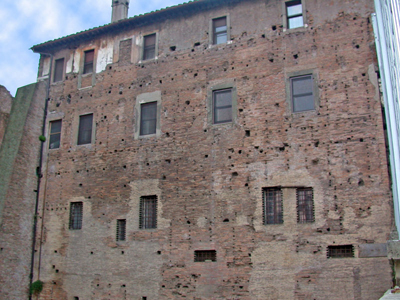Archaeologists hope to find more pieces of the ancient Forma Urbis Severiana, a marble map that was attached to the wall of the Temple of Peace in Rome. A plan of the city during the time of the Roman Emperor Septimius Severus (193-211 AD) was incised on 150 marble slabs, arranged in eight rows and covering an area of 60 by 43 feet. It shows in astounding detail the layout of streets with housing insulae, temples, bath houses and commercial areas.
Several pieces of the world’s oldest and largest unsolved jigsaw puzzle, a 2,200-year-old map of Rome made of thousands of marble fragments, could be unearthed next year following construction work for a new metro line near Rome’s majestic forum area.
“This is a unique occasion to excavate the Forum of Peace, where the map once stood,” Rossella Rea, director of the Colosseum, told the Italian financial daily “Il Sole 24 Ore.”
Carved into marble slabs around 210 A.D., during the rule of the emperor Septimius Severus, the map was originally hung on a wall in the Templum Pacis (Temple of Peace), which stood in the middle of an enclosure called Forum of Peace.
The wall still survives today in a building near the 6th-century Church of Santi Cosma e Damiano. Rows of holes where the map was attached using bronze clamps can still be seen.

Reporter Rossella Lorenzi mentions the fascinating connection with the destruction of the Temple of Jerusalem in 70 AD:
The centerpiece of the Forum of Peace was indeed the temple. Built in 71-75 A.D by Vespasian, the Temple of Peace celebrated the brutal pacification of the Jews and the destruction of the Temple at Jerusalem in 70 A.D.
Tons of gold, silver trumpets and gold candelabra were plundered from the Jerusalem temple and paraded through Rome’ streets in triumph.
The moment was captured in a frieze carved into the Arch of Vespasian’s son, Titus, which clearly shows the menorah, the seven-branched temple candelabra that was the symbol of ancient Judaism, being exposed through the streets.
Between 75 A.D. and the early 5th century, the treasure, which helped finance the building of the Colosseum, was put on public display right in the Temple of Peace.
Although it is unlikely that fragments from the treasure are unearthed, the archaeologists hope to bring to light other precious remains from the Forum of Peace.

HT: Joe Lauer

2 thoughts on “The Destruction of Jerusalem’s Temple and Rome”